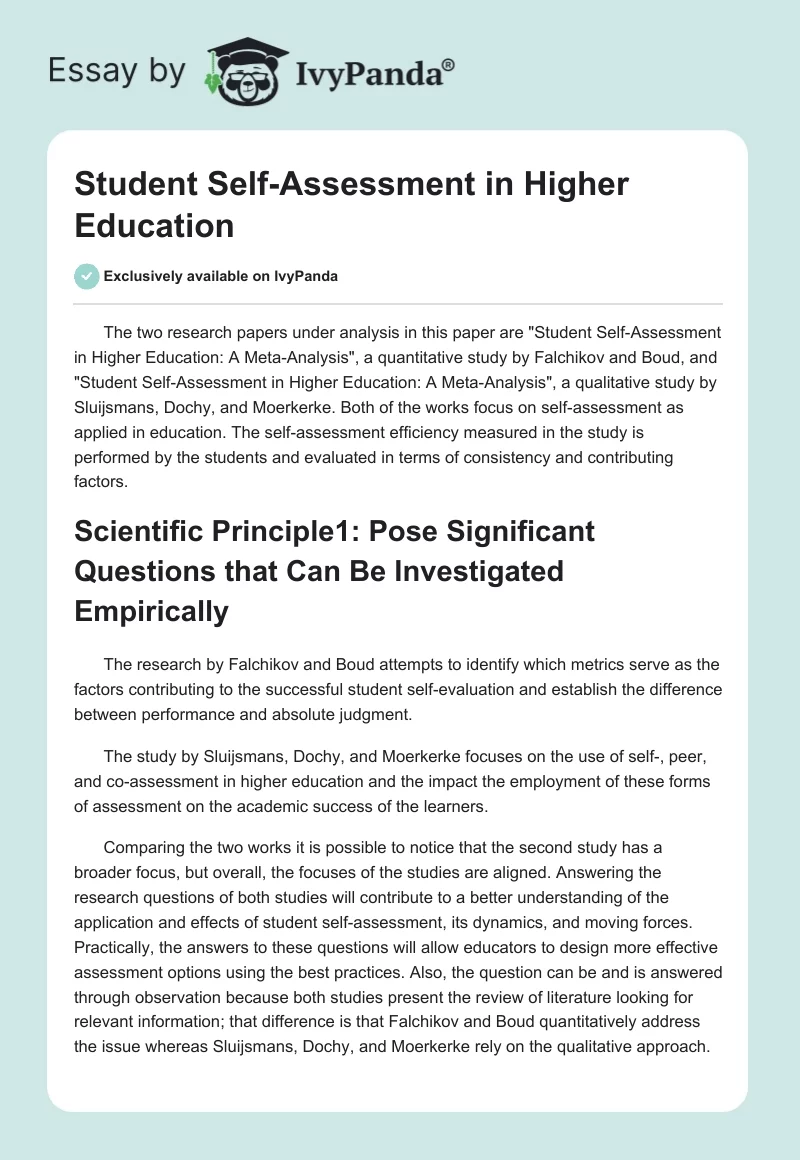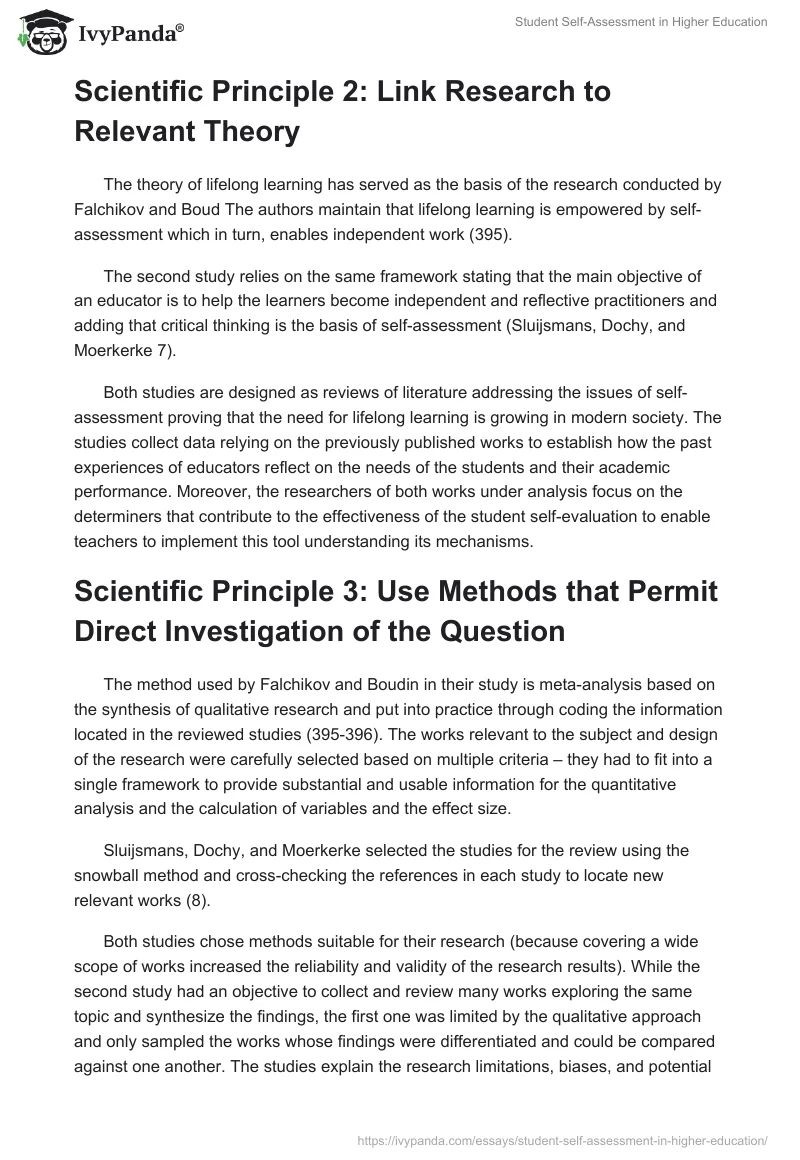The two research papers under analysis in this paper are “Student Self-Assessment in Higher Education: A Meta-Analysis”, a quantitative study by Falchikov and Boud, and “Student Self-Assessment in Higher Education: A Meta-Analysis”, a qualitative study by Sluijsmans, Dochy, and Moerkerke. Both of the works focus on self-assessment as applied in education. The self-assessment efficiency measured in the study is performed by the students and evaluated in terms of consistency and contributing factors.
Scientific Principle1: Pose Significant Questions that Can Be Investigated Empirically
The research by Falchikov and Boud attempts to identify which metrics serve as the factors contributing to the successful student self-evaluation and establish the difference between performance and absolute judgment.
The study by Sluijsmans, Dochy, and Moerkerke focuses on the use of self-, peer, and co-assessment in higher education and the impact the employment of these forms of assessment on the academic success of the learners.
Comparing the two works it is possible to notice that the second study has a broader focus, but overall, the focuses of the studies are aligned. Answering the research questions of both studies will contribute to a better understanding of the application and effects of student self-assessment, its dynamics, and moving forces. Practically, the answers to these questions will allow educators to design more effective assessment options using the best practices. Also, the question can be and is answered through observation because both studies present the review of literature looking for relevant information; that difference is that Falchikov and Boud quantitatively address the issue whereas Sluijsmans, Dochy, and Moerkerke rely on the qualitative approach.
Scientific Principle 2: Link Research to Relevant Theory
The theory of lifelong learning has served as the basis of the research conducted by Falchikov and Boud The authors maintain that lifelong learning is empowered by self-assessment which in turn, enables independent work (395).
The second study relies on the same framework stating that the main objective of an educator is to help the learners become independent and reflective practitioners and adding that critical thinking is the basis of self-assessment (Sluijsmans, Dochy, and Moerkerke 7).
Both studies are designed as reviews of literature addressing the issues of self-assessment proving that the need for lifelong learning is growing in modern society. The studies collect data relying on the previously published works to establish how the past experiences of educators reflect on the needs of the students and their academic performance. Moreover, the researchers of both works under analysis focus on the determiners that contribute to the effectiveness of the student self-evaluation to enable teachers to implement this tool understanding its mechanisms.
Scientific Principle 3: Use Methods that Permit Direct Investigation of the Question
The method used by Falchikov and Boudin in their study is meta-analysis based on the synthesis of qualitative research and put into practice through coding the information located in the reviewed studies (395-396). The works relevant to the subject and design of the research were carefully selected based on multiple criteria – they had to fit into a single framework to provide substantial and usable information for the quantitative analysis and the calculation of variables and the effect size.
Sluijsmans, Dochy, and Moerkerke selected the studies for the review using the snowball method and cross-checking the references in each study to locate new relevant works (8).
Both studies chose methods suitable for their research (because covering a wide scope of works increased the reliability and validity of the research results). While the second study had an objective to collect and review many works exploring the same topic and synthesize the findings, the first one was limited by the qualitative approach and only sampled the works whose findings were differentiated and could be compared against one another. The studies explain the research limitations, biases, and potential reliability and validity issues. Also, a detailed description of the procedure is provided in each study so the other researchers could repeat it.
Scientific Principle 4: Provide a Coherent and Explicit Chain of Reasoning
The study by Falchikov and Boud specifically selects the qualitative literature to conduct the calculations adequately and establish numerical indicators for the defined dependent (correlation, coefficient, effect size, and percentage agreement) and independent (subject areas of the studies, their participants, criteria used, standard deviations) variables (397).
In the study by Sluijsman, Dochy, and Moerkerke, the authors inform that the data is selected for the narrative review based on patterns, and the integration will be an intuitive undertaking (9). This statement implies an interpretation bias that is a threat to validity and reliability.
The authors of both studies take the required measures to inform the readers of the possible weaknesses, limitations, and biases. The second study emphasizes that the explanations given by the researchers are intuitive, and the other interpretations are possible as well. The first study is more precise as it relies only on numbers and differentiated variables that match throughout the selected works.
Scientific Principle 5: Replicate and Generalize Across Studies
Falchikov and Boud mention the previous research targeting the same subject that had a different method and focused primarily on the evaluation of the self-assessment studies in education (396). The authors emphasize that the main limitation of the present quantitative research is the inconsistency of methods, scales, and criteria used in other studies. This tendency resulted in difficulties selecting the articles for the synthesis.
Sluijsmans, Dochy, and Moerkerke indicate that similar studies have been published previously, but there is a need for an ongoing synthesis of the growing body of information (7). That is why the narrative reviews and literature reviews are necessary.
The latter study can be extended through the coverage of a larger number of sources; the former requires a stronger consistency between the individual studies researching student self-assessment because otherwise, it becomes impossible to counter compare the findings using qualitative methods. Both studies note that self-assessment is a specific subject and many factors impact its results – the levels of students, specialization, teaching methods used.
Scientific Principle 6: Disclose Research to Encourage Professional Scrutiny and Critique
The study by Falchikov and Boud was published by Sage and on behalf of the American Educational Research Association (AERA) (395). Besides, the authors express gratitude to the individuals who made comments on the earlier draft of the research.
The work by Sluijsmans, Dochy, and Moerkerke was published by Educational Technology Expertise Center (Otec) Open University of the Netherlands and is regarded as a part of the Otec Report series (1).
Both of the studies have been reviewed and are trustworthy academic sources of scholarly knowledge.
Works Cited
Falchikov, Nancy, and David Boud. “Student Self-Assessment in Higher Education: A Meta-Analysis.” Review of Educational Research 59.4 (1989): 395-430. Print.
Sluijsmans, Dominique, Filip Dochy, and George Moerkerke. “Student Self-Assessment in Higher Education: A Meta-Analysis.” Otec Report Series (1998): 1-36. Print.


